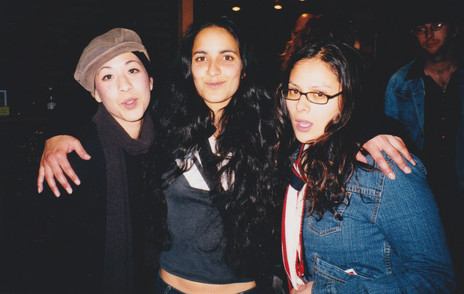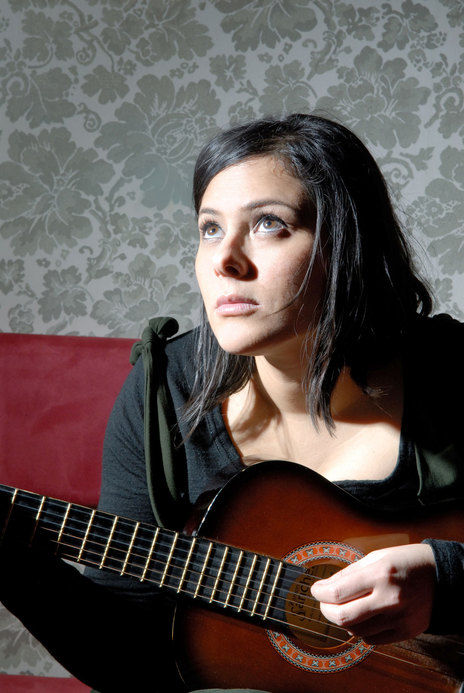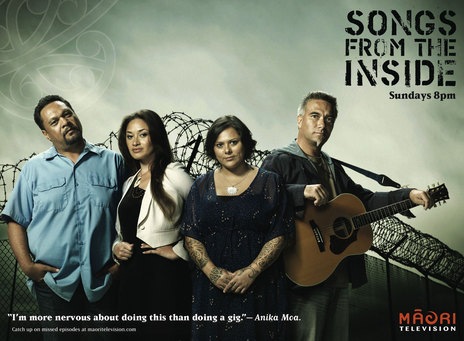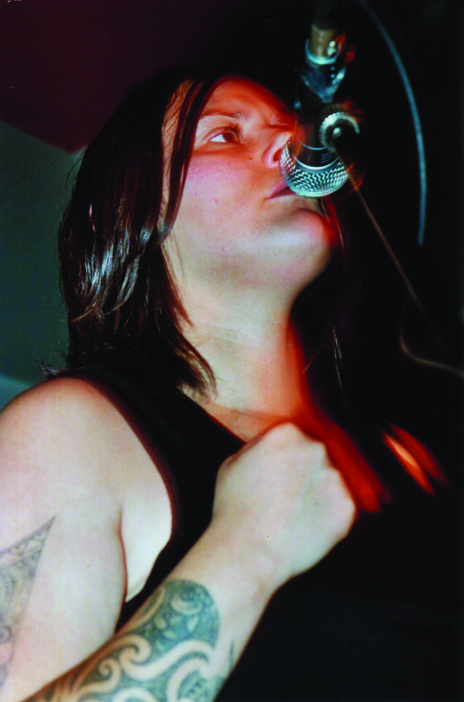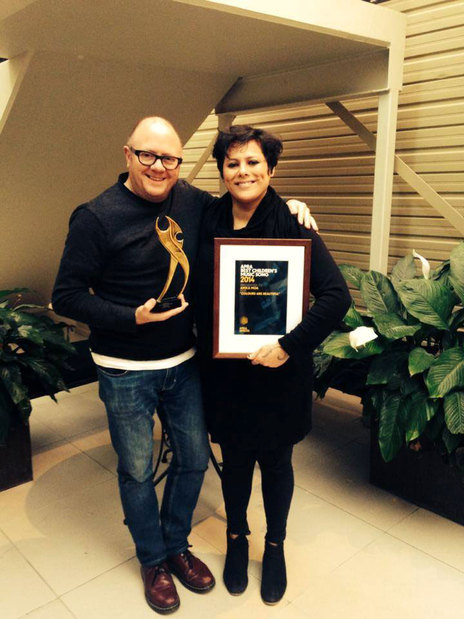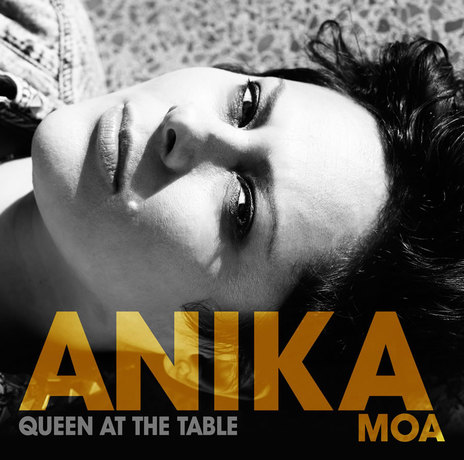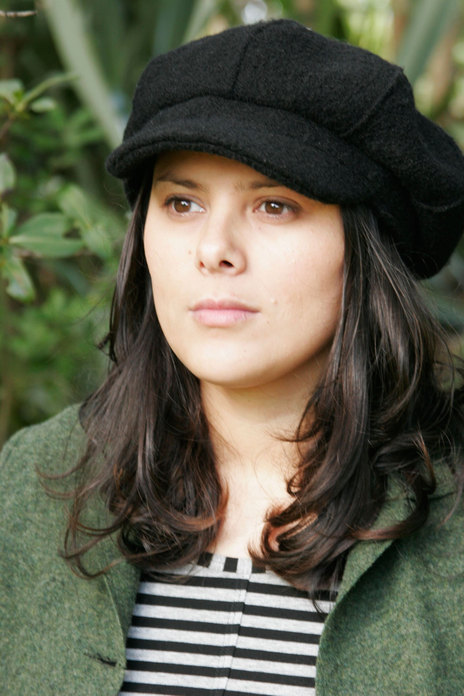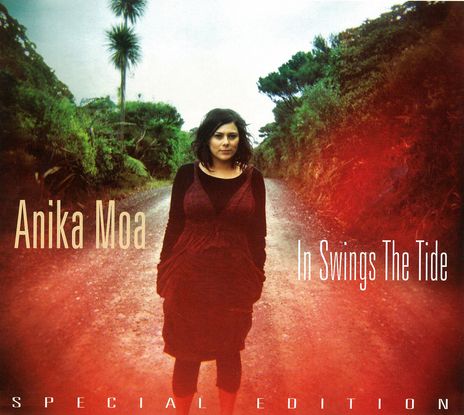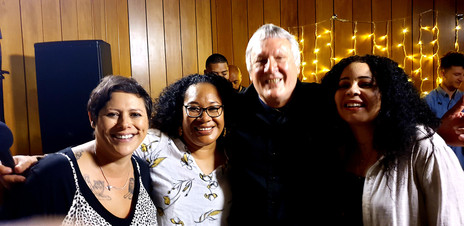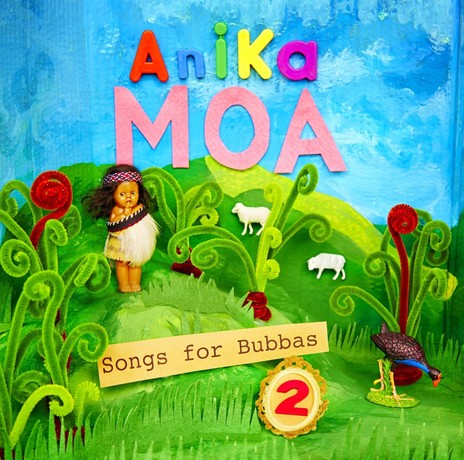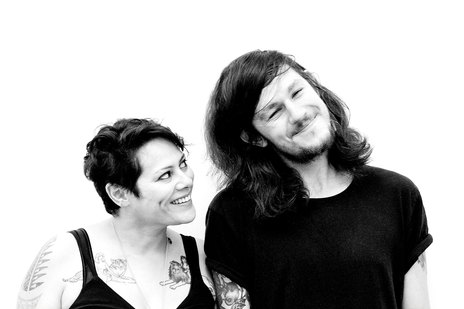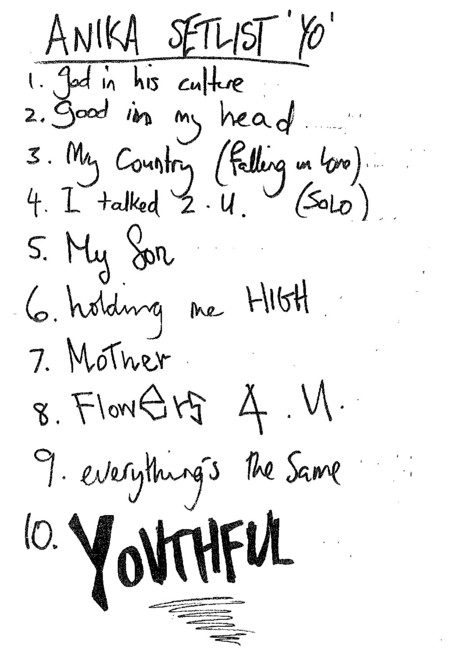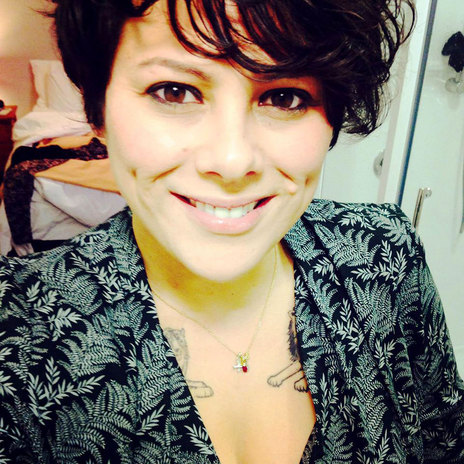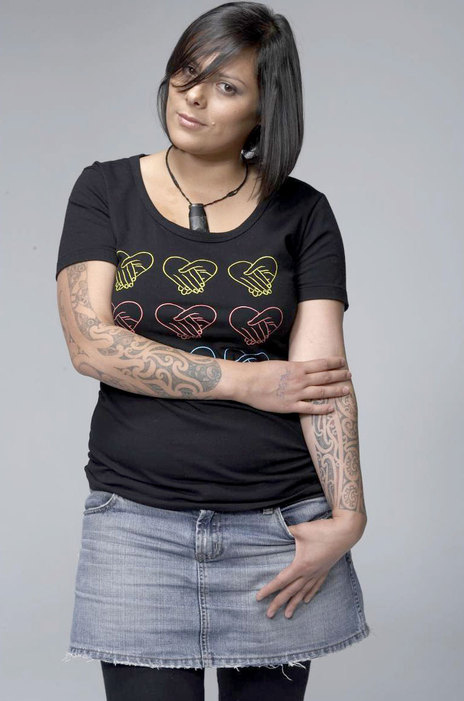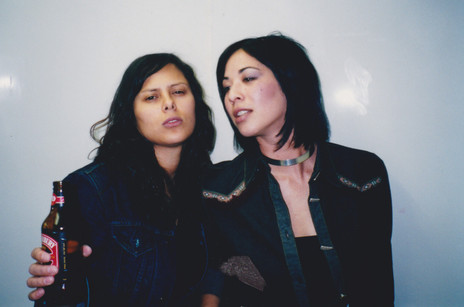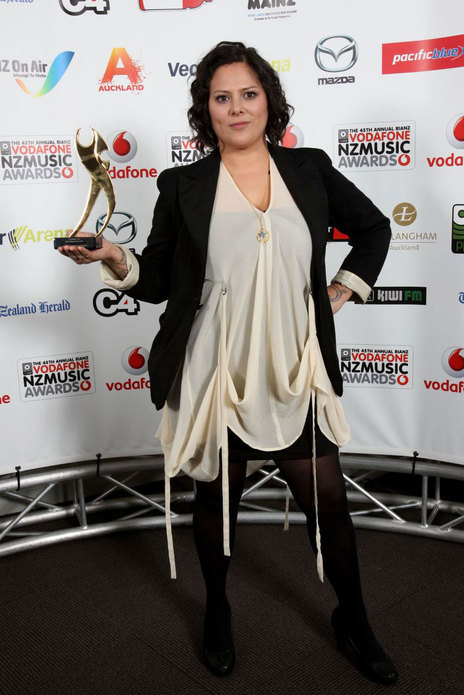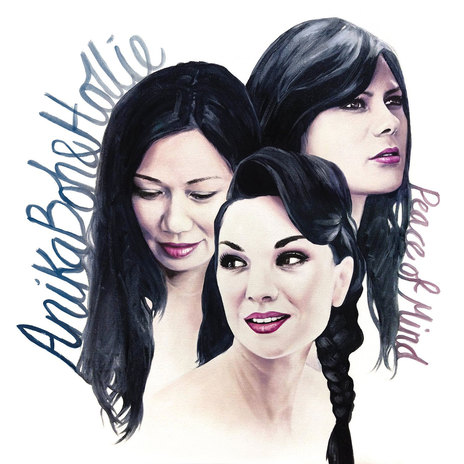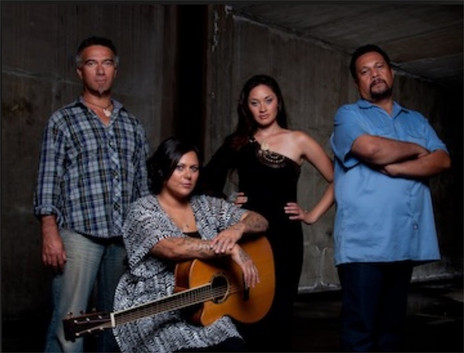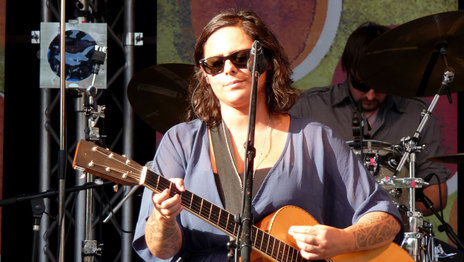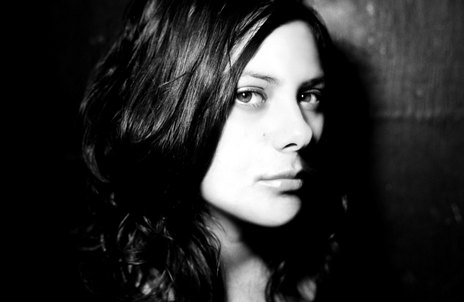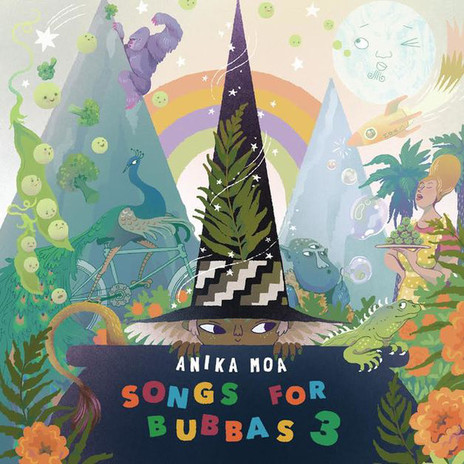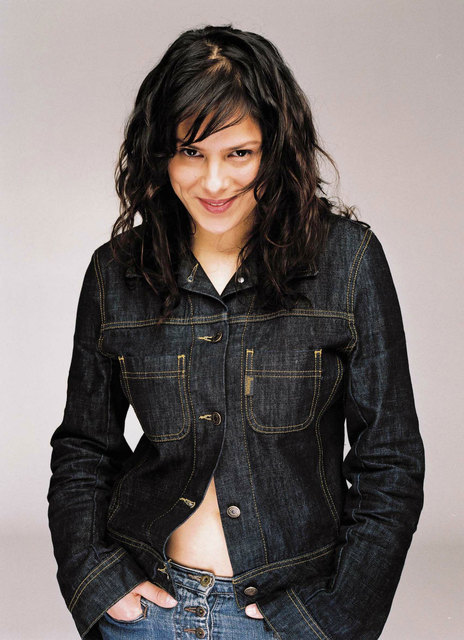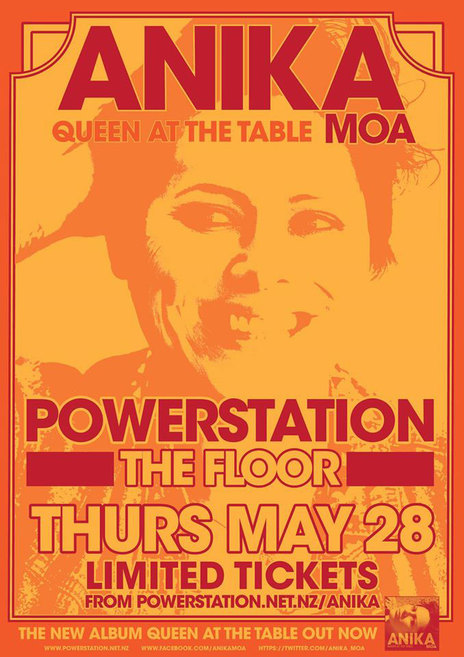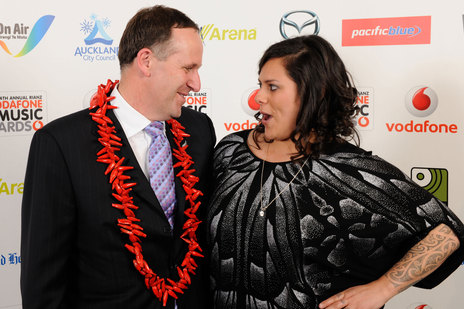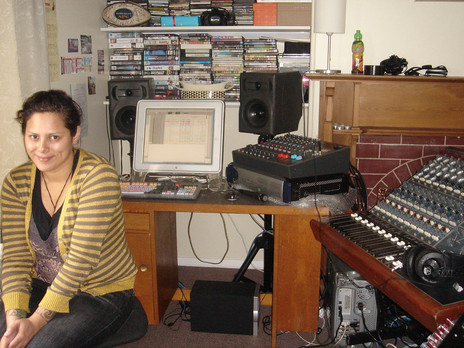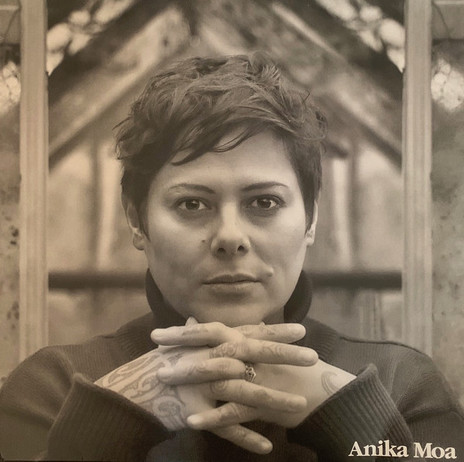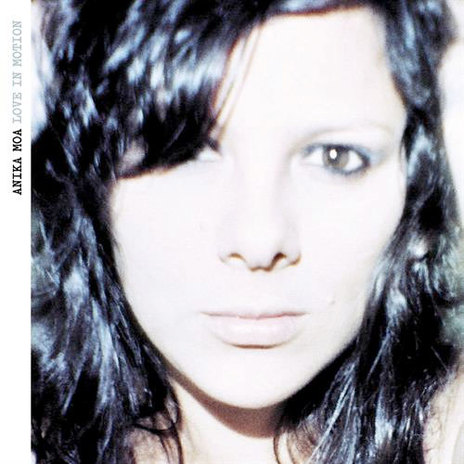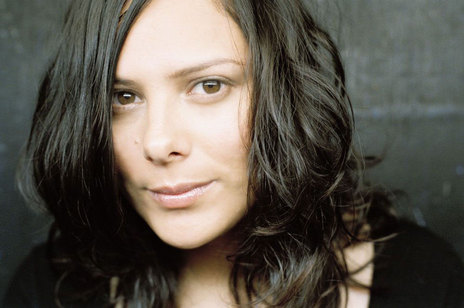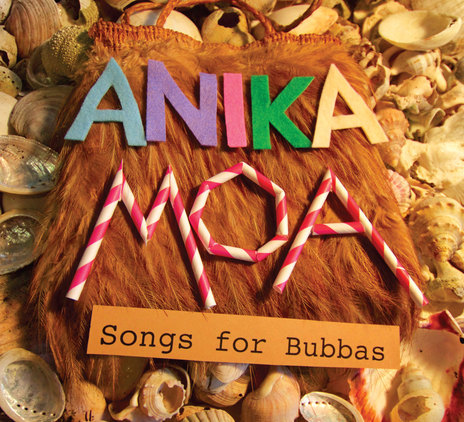Born in Papakura, Auckland in 1980, but raised in Hornby, Christchurch, Anika Rose Moa descends from Ngāpuhi and Te Aupōuri on her father Tia’s side. Moa’s passion for music was instilled in her by her (English) mother Bernadette, and as she and her siblings got older they sometime joined Bernadette onstage with her band.
Her performance debut came at eight years old, performing at a talent quest at Hornby mall, singing ‘Pink Cadillac’ by Natalie Cole – she came second.
Moa met her father when she was a teenager, a turning point for her as he introduced her to the guitar.
Throughout her career, Moa’s songwriting influences have been varied, but female singer-songwriters have always been inspirational. “I love lots of music, but if I’m honest, it would have to be … Dolly Parton, Joni Mitchell … it’s that whole strong great woman singer songwriter styling.”
Early days
After meeting her father at age 13, Moa started writing songs. “My dad … he put a guitar in my hands and said 'play the guitar', so I started playing it,” she says. “My mum was in a band as well, so every Thursday Friday, Saturday I’d go to her gigs with her, and watch her, and just be in awe of her! I used to think she was like Madonna! A superstar.”
at Hornby High School, Moa joined musicals, choirs, and rock groups, falling deeply in love with music.
Moa’s ambition grew while attending Hornby High School, joining musicals and choirs, as well as rock groups, and falling deeply in love with music. This learning ground wasn’t always easy going.
“It was a real boys group, [they] were like 'you can’t sing, you can’t play guitar, you can’t write music,'” she admits. “That fired me up. I was like “you’re dumb, spazzy and ugly, and you know what? You can’t play your instruments either!” So I learnt how to play guitar. I didn’t need to learn how to sing, I already knew how to sing.”
Moa started entering the Rockquest Songwriting lyrics competition, and won every year she entered. In 1998, she entered as a solo act, winning the Most Promising Female Musician award and a scholarship to Nelson School of Music for her song ‘Flowers for You’. This (along with ‘Youthful’) was included in a compilation album of the finalists, and sent to managing directors of local branches of major international labels.
As fate would have it, the boss of Warner NZ heard it, loved it, and arranged for Moa to record a demo, which found its way into the hands of the head of Atlantic Records. Moa (now based in Auckland) travelled to New York and performed her songs for him, barefoot in his office (as the legend goes). She was signed on the spot, and returned in April 2000 for six months to record her debut album, Thinking Room, with producer Victor Van Vugt, who had worked with Nick Cave and the Bad Seeds, PJ Harvey, and The Fall, among others.
Stellar beginnings
Anika Moa’s career started with a big bang, when Thinking Room was released in August 2001, and went to No.1 locally, a double-platinum release in New Zealand. The album yielded four huge singles, including ‘Youthful’, and ‘Falling in Love Again’, which was featured on the soundtrack of the Julia Roberts film America’s Sweethearts. Moa is a bit embarrassed by the song, which she says was written “half-heartedly”.
Thinking Room didn’t really take off in the US, and Moa was homesick, and increasingly unimpressed with her Warner contract: she had little say in the way things were progressing, and found the portrayal of her to be superficial. Scott Kara, writing in Rip It Up in 2002: “America … wants the Barbie doll Anika …[she] doesn’t exist.”
“It’s that whole game of when you sign with an American record label. They just own you, you will not have a brain anymore, and nah, that’s not me,” Moa states. “I didn’t know what I was getting into … but I appreciated that they put so much money and effort into me. I wouldn’t do what they wanted me to do: they constantly told me [to] lose weight … what’s that got to do with my songwriting? I’m… not fooled by anyone, so I was like, fuck ya’s, frankly.”
Instead of remaining in America to support Thinking Room, she turned her back on the US promotional treadmill and returned to New Zealand in 2002. To document her time in the US recording the album, and her subsequent return home, the documentary Three Chords and the Truth: the Anika Moa Story, showed what happened with Moa and her Warner deal.
Moa wanted to be successful – “but I wanted to do it my way.”
“I got a lot of shit from a lot of people, mostly my [then] manager, he just wanted me to be … successful. I did too, but I wanted to do it my way,” Moa admits. “I don’t think anyone should own anyone … the whole creative process of songwriting is hard enough without people putting other ideas in.”
Thinking Room still holds a special place for Moa. “I still love it, and I still admire it for what it was. I remember coming home to NZ and being really proud knowing that it was going to be successful because I’d worked hard at it.”
On Moa’s return to New Zealand, she went on her first national tour, supporting Tim Finn.
Developing styles
Moa followed Thinking Room with a more stripped back second album, Stolen Hill, released in August, 2005. Sonically sparser, and confessional, Stolen Hill was preceded by the delicate and heartbreaking single, ‘In The Morning’, and recorded with producer Ed Cake in a barn at Bethells Beach (Te Henga), West Auckland. The album delves deep in Moa’s personal history, and is imbued with a sense of the political and cultural, looking at tangata whenua, nationhood, environment, and the state of Māoridom.
Moa’s musical influences were broadening too. “I was getting into quite a lot of blues music, and jazz, so my inspiration grew from that,” she says.
Stolen Hill also revealed a songwriter at a personal crossroads. “The song ‘Stolen Hill’ was about the woman that I fell in love with, when I first realised I was gay, and it’s about the most pure love for someone, and the fact that if I died, she’d totally move on, and that’s okay,” she explains. “‘Picture me in the 70s’, I actually wrote that when I was 17… looking back on the lyrics, I realise I was probably actually gay back then,” she laughs. “It’s a special album for me.”
Stolen Hill gained mixed reviews: Russell Baillie in The New Zealand Herald called some material “an unlikely marriage of style and substance”, with Moa “over-reaching lyrically”, though he did see the album’s strengths; New Zealand Musician called the album “full of heartfelt meaningful tracks.”
To promote Stolen Hill, she embarked on a nationwide tour with her newly formed Plastic Tiki Band, before decamping to Monte Cecilia House as part of Bic Runga’s backing band for her Birds album (along with Neil Finn, Anna Coddington and Shayne Carter) – which also included a full Australasian tour.
In 2005, Moa also contributed to the recording of ‘Anchor Me’ (originally by The Mutton Birds) for Greenpeace’s 20th anniversary commemoration of the sinking of the Rainbow Warrior in Auckland harbour. Also involved in this recording were Kirsten Morrell (Goldenhorse), Che Fu, and Hinewehi Mohi, (among others).
Two years later, in October 2007, Moa followed up Stolen Hill with her third long-player, In Swings the Tide, which was inspired by the break-up of her relationship, and her father’s deteriorating health. Moa produced and mixed the country-tinged folk-pop album, and says it marks huge changes in her life.
“That’s when my dad died. And, I met my wife, who is now my ex-wife. And, it’s got a country twang, which I loved. The songwriting, it was just pop songwriting.”
In Swings the Tide showed Moa as a storyteller through song. “There’s a song I wrote for my dad, ‘My Old Man’, that took a year to write. It was the hardest song I ever wrote … I wanted to finish it before he died … It’s quite a harsh song because I basically say he came out of my life, he came into my life, he was a bit of a shit father, he’s a bit of a broken man, and he’s fuckin’ dying,” she says.
‘In Swings the Tide’ showed Moa as a storyteller through song.
“It’s really hard to write lyrics about that, especially about someone about to die. And he loved it, he took it very well. I had a very open, honest friendship with him … I always said to him ‘I don’t see you as my father, I see you as this person I know and love, and who I adore, and who I’d do anything for … his inspiration … is in my music because I am him. I am my dad … I live my dad’s life except I don’t do drugs, or mushrooms or P!”
Moa toured the album nationally with long-term collaborators Chip Matthews and Nick Gaffaney, and it peaked at No.6, selling close to double-platinum, with much acclaim: the following year ‘Dreams In My Head’ was nominated for an APRA Silver Scroll, and she won Best Female Vocalist at the Vodafone NZ Music Awards.
2007 was a big year for Moa personally. She came out as lesbian, something she regrets not doing earlier. “I didn’t come out until I was about twenty-seven, which I quite regret,” Moa states. “I really wanted to own the fact that I’d turned gay, and I couldn’t.”
Motion and flux
Moa’s next move was to write an album on the weighty theme of love. In 2009, Moa and new partner Azaria Universe (Angela Fyfe) were based in Melbourne, were Fyfe was working, and Moa, bored and lonely, started to write. “I wrote it in an apartment we were renting ... I was going to the gym quite a lot, and being really healthy, and not drinking. I quite enjoyed the whole process, except for the writing! I was like ‘I’m bored, I’m lonely’, and it pushed me to write that album”, she explains.
Many of the songs dealt with Moa and Fyfe’s relationship while lead single ‘Running Through the Fire’ was about the death of her father, and ‘Secrets and Lies’ was aimed at someone who had seriously annoyed her. The sound on Love in Motion was guitar-based rock, with layered vocals and guitars, as opposed to the acoustic, folk influenced In Swings the Tide. The recording took place over two weeks at Roundhead Studios, Boatshed Studios, and Radio New Zealand, with Moa producing the album with Andre Upston. The recording was a social experience – friends, family and Fyfe were all part of the process.
Moa then road-tested the finished songs on the Aroha tour, a joint 25-date tour in 2009 with Julia Deans, who was performing material from her upcoming album Modern Fables. Documenting the creation of the album, and Moa’s relationship with Fyfe, was the second documentary on her – In Bed with Anika Moa, for TVNZ’s Artsville. Moa rounded off 2009 by contributing backing vocals to the Dimmer album, There, My Dear, and played two South Island shows with friend Tim Guy.
the ‘Love in Motion’ went Top 10 on the NZ album charts in 2010.
Love in Motion, released in 2010, went Top 10 on the NZ album charts, and again met with positive reviews – many critics comparing Moa to rock-chicks Pat Benatar, Ladyhawke, and Sharon O’Neill. Moa toured the album with her band (including Geoff Maddock, Chip Matthews, and Nick Gaffaney) later that year, and won Best Female Solo Artist at the 2010 Vodafone New Zealand Music awards
That year, she and Fyfe entered into a civil union partnership, the couple becoming parents to twin boys in 2011.
Supergroups and collaborations
While in Melbourne writing Love in Motion, Moa got a call from Jon Toogood. “I love him,” she says emphatically. “He rang me, and was like ‘Hey, Neeks, how’s it going, let’s meet up’. I was so in love with Shihad, it was crazy.” This phone call led to Moa’s involvement with supergroup The Adults in 2011 (with Toogood, Deans, Carter and Ladi6, among others), and she wrote two songs with Toogood for the album, ‘A Part of Me’ and ‘Sleep me Tight’. Moa says the process was simple. “I just went to a studio with Jon … I wrote two songs with him, and recorded them. I thought they were demos, and then all of a sudden they were on the album!”
Another supergroup was mooted for Moa in 2010, Allusionz (a link back to her mother’s group Illusions), a girl-group with Deans and Anna Coddington. While the project didn’t eventuate, Moa is keen to revisit the trio, saying, “it was garage band music! Nothing flash, it was very interesting.”
Instead, a trio comprising of Moa, Boh Runga, and Hollie Smith formed (as AnikaBohHollie), and released the album Peace of Mind in 2013, co-produced by Jol Mulholland, who was a key musical presence in the studio. Moa enjoyed this experience greatly. “We came about because we’re all friends, and we just wanted to do an album together.” AnikaBohHollie and The Adults toured New Zealand with Fat Freddy’s Drop in early 2013 as part of the Winery Tour.
In September 2013, Moa joined the collective troupe Fly My Pretties for their ‘Homeland Tour’, and subsequent album (The Homeland Recordings), contributing the piano and acoustic guitar based ‘Cry’.
Backtracking slightly to 2012, Moa (along with TrinityRoots' Warren Maxwell, Maisey Rika and Ruia Aperahama) was involved in Songs From the Inside, a 13-part television series that took the musicians inside Arohata and Rimutaka prisons to record music with 10 inmates. The musicians taught songwriting, and helped the prison inmates write the songs, which were then recorded for album release. Moa told Scott Kara at the New Zealand Herald, “I believe in music being an integral part of the healing, learning and keeping-your-mind-busy process” and signed on for series two in 2014, which featured Don McGlashan, Leighton Kora, and Annie Crummer.
New Directions
In 2013, Moa and Fyfe separated. Moa channelled her emotions into writing her children’s record, Songs for Bubbas, for her twins – and partly to save herself and other parents from relentless sound of The Wiggles – and starting work on a new album. Songs for Bubbas in particular was a high point.
“It was a saviour for me. Andre Upston and I … we recorded it very quickly in his studio … and it was fun, it was lively. When I recorded it, I didn’t have any troubles, it was all about the kids. I’d come home and say ‘hey boys, listen to this.’ I’m so happy and proud about it. It’s one of my proudest albums.” Songs for Bubbas has been equally successful, winning a Tui award for Best Children’s Music Award, and ‘Colours Are Beautiful’ winning Best Children’s Music Song of the Year at the 2014 New Zealand Music Awards.
With an eye on a new solo album, Moa again toured nationally with Julia Deans in early 2014, playing newly written material. She continued to tour, embarking on the So Good They Named It Twice tour with X-Factor semi-finalist Benny Tipene, taking in towns Kihikihi, Matamata, and Kerikeri, and then playing three gigs in Christchurch with local folk artist Mel Parsons.
Following this, she and Mulholland decamped to The Lab Recording Studio to further write and record her sixth album, Queen at the Table, which was released in April 2015.
‘Queen at the Table’ was produced and co-written with Joel Mullholland.
“I just connected with him straight away,” Moa says of Mulholland, “Everything’s fifty-fifty. I wrote the songs. I wrote the melodies and the chords, and he wrote these beautiful, beautiful choruses … he’s a genius in my eyes. He helped me create new melodies and new paths in my songwriting.”
Queen at the Table is produced by Mulholland, and thematically focuses on Moa’s separation from Fyfe – especially in ‘Running’, and ‘These Lonely Tears I Cry For You’ – though the light of new love creeps into the album too.
Moa finds writing about her life cathartic. “I think it’s a good way to get a sad, horrible, lonely message across,” she muses. “I don’t write about anything but what I’m doing at a specific time. So if I’m not doing to well at a specific time, I’ll write about it. I’m not shy to speak up about how I feel.”
Queen at the Table moves away from Moa’s familiar style of acoustic guitar based singer songwriter, embracing electronic, synth-based sounds, finding that she and Mulholland were on the same page. “We discovered along the way is that our love for guitar music had waned. And, we both liked music with quite a lot of electronic beats, and lots of keyboards. It’s a different world for me, because I’ve always just been a band chick, you know rock chick … I think it’s all about evolving as an artist and as a songwriter, and that’s exactly what I’ve done!”
Working with a new style and a new collaborator has changed Moa’s approach to songwriting, at least in structures. “I tend to do a normal pop-sense song, with verse-chorus-verse-chorus-bridge-chorus, this time around I wanted to say what I wanted to say. Do a catchy-as chorus, and just get out what I can. And bridges were very minimal. I also let Jol indicate where the song was going to go, you know, keep it a little bit spazzy.”
To further prepare the new material, Moa toured with Dave Dobbyn (her favourite, she says), Don McGlashan, and Supergroove as part of the 2015 Winery Tour, with Mulholland as musical collaborator.
--
Anika unleashed: an AudioCulture update, 2020
The first review for Queen at the Table was a rare five stars from Gary Steel in Metro. “Many break up albums are just miserable,” he wrote, “but Anika has kept craft to the fore, never wallowing, always finding a way to universalise her experiences through performances that are skilfully executed as they are beautifully expressive. There’s pain here, but joy too, and it’s all wrapped up in pop songs with just a bit of R&B Diva running through them. Anika-style.”
Writing for NZ Musician, Amanda Mills agreed that it was a skilful take on electronic pop, concluding “it proves a successful artistic evolution for Moa – a musician unafraid to take a chance on the new.”
Off the back of the album came Songs for Bubbas 2 – a no-brainer considering the massive success of its predecessor. “I can pay my rent now,” Moa joked to The Spinoff’s Alex Casey. “Songs for Bubbas 1 and 2 have absolutely defined me as a person and as a mother and as a woman. I’ve helped so many women in this country get their kids to sleep and I don’t know how I did it. All I did was I did everything from my heart.”
Moa’s unexpected turn into children’s entertainment has given her career a certain duality. “I’m really living two lives between doing my adult gigs and being naughty, and then doing kids’ gigs and not swearing and being Aunty Anika.”
The double life of children’s entertainer and singer-songwriter quickly turned into a triple life.
That double life of children’s entertainer/singer-songwriter quickly turned into a triple life, with Moa adding television presenter to the mix. It all started in 2015, when Face-to-Face with Anika Moa launched on NZ Herald online – a laid-back chat show with local musicians that showcased her hilarious and, at times, outrageous interview style. Next came All Talk with Anika Moa on Māori TV, followed by a stint covering Jeremy Wells alongside Hilary Barry for Seven Sharp – a high honour for a novice in the profession.
If it was a test, she passed, as she landed her own TVNZ chat show in 2018. In Anika Moa Unleashed she interviews some of New Zealand’s most well-known and/or controversial public figures with her signature cheek and candour. From calling Paula Bennett “Paula Benefit”, to doing a Helen Clark impersonation to Helen Clark, to getting Sam Neill to swear on camera, it was exactly what the audience wanted from her. The reception from critics was also glowing, with Moa picking up best entertainment presenter at the 2018 New Zealand Television Awards
The success of her new ventures did not mean the end of Moa’s “adult music” (as she calls it), but time to write was hard to find, especially considering her busy family life. In 2017 Moa married reporter/producer Natasha Utting, whose son joined their blended family of now three boys. Nonetheless, Moa never stopped chipping away at new lyrics; it’s a necessity for her.
“I see the songs like a cheap version of therapy,” she told RNZ’s Kim Hill in 2018. “The only way I can work through a problem is by writing about it. Even if it’s a good thing, even if it’s happy.”
After an 18-month period of intermittent songwriting, Moa flew to America for the recording of her eighth studio – and first self-titled – album.
Anika Moa was recorded in eight days at New Orleans’ beautiful Esplanade Studios, a renovated church that had been abandoned in 2005 after Hurricane Katrina put it three metres under water. Although the musicians were American, producer Brady Blade had spent a lot of time in New Zealand, and produced Brooke Fraser’s debut album What to do With Daylight in 2003, and worked with Annah Mac and Annabel Fay.
“It’s an American sounding album … that’s the sound I wanted,” Moa told Hill upon its release. “I’ve done heaps of New Zealand-sounding albums. I wanted to try something new … there’s an electronica album, there’s a rock album, there’s a pop album … people should know that about me by now, that I do not sit with any genre or style, I just go with what I need to go with.”
The sound she created with Blade was polished, heartfelt pop, with surprisingly sad lyrics – only surprising due to the high-octane comedy she had been making for her chat show the very same year. As she told Hill, “Everyone must develop their feelings and everyone must go through their vulnerable side. And even though I do funny things and try to be comedic all the time, I am a human being, and human beings feel, and I feel deeply – not deeply enough, but I try my best.”
Critical reception was positive, particularly to the vulnerability Moa presented in her lyrics. The Spinoff’s Henry Oliver aptly noted, “The album combines ‘that Americana sound’ with a 90s rock edge and, at times, classic singer-songwriter guitar pop. It sounds full and direct. There’s nowhere for the songs to hide, nowhere for Anika Moa to hide. The best songs are the saddest songs, the ones where the guitars sound like they’re crying to the story they’re accompanying, the ones that make you feel like you’re in the same room as the band, hearing something maybe you shouldn’t.”
The album’s first single, and perhaps the most 90s sounding, ‘Buttercup’, went on to make the 2019 Top 20 shortlist for the APRA Silver Scroll Award.
Returning to her other day job in 2019, Moa launched the second season of chat show Unleashed, winning her another trophy for best entertainment presenter at the 2019 New Zealand Television Awards.
And as for her other, other day job, she released Songs for Bubbas 3, winning her te kaipuoro waiata tamariki toa/ best children’s music artist at the 2020 Children’s Music Awards. It seems there is nothing she can’t do. And with her numerous paid sponsorships – from cars to supermarkets to smartphones – it also feels like there is nothing she won’t do. “It’s a dream because I’m poor,” she mused to Alex Casey. “I’m just a normal musician who has three children and struggles to survive.”
VISIBILITY OF RAINBOW FAMILIES IS EXTREMELY IMPORTANT TO HER.
Moa’s significant social media presence has brought with it many opportunities for paid promotion, and she is planning to take the next step of any bona fide influencer by starting her own brand: baby products inspired by her new daughter Marigold, born in early 2019.
Among her television gigs, ad campaigns and co-hosting The Hits Drive Show, Moa still performs as a singer-songwriter when she can, but generally prefers to have the evenings free for her young family. They play a major role in her public image, especially on social media, and that has been a conscious decision. As she told Stuff in 2019, visibility of rainbow families is extremely important to her: “I feel like if there were role models like that in my day I might not have been in the closet for as long as I was ... You wouldn’t feel as distracted by what people think and that kind of shit.”
Anika Moa’s career has taken her to some interesting places and experiences. “Being kind to other people is the most important thing that I’ve realised you can do … you can work with real meanies, and it’s not a nice thing to wake up and work for meanies,” she says.
Authenticity is also fundamental to her music, and she knows her fan base is smart. “You have to maintain who you are … you just have to be you – no matter what! And people love it, people dig it. If you conform at all at any time, people will turn their heads.”
--
Updated November 2020 by Rosie Howells
